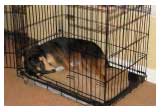Why This is Important

Many people have a deep bond with their pets. If your animals are true members of the family, they must be included in your family's emergency planning and preparations.
Keeping pets indoors helps prevent them from bringing disease into the house. This is especially true for cats and dogs, as the H5N1 flu virus has infected both.
What You Can Do Now
 1. Ensure your pet is properly identified.
1. Ensure your pet is properly identified. Identification tags should have your name, address, phone number, and phone number of your vet. Consider checking with your vet about micro-chipping your pet.
2. Have your pets spayed or neutered NOW to prevent wandering, to allow your pet to be more comfortable inside the house, and to prevent unwanted animals during a pandemic.
3. Create a plan to bring outdoor pets indoors. Consider each pet’s personality and needs, and prepare to separate animals that cannot co-exist together (separate rooms, feeding animals separately, providing supervision to prevent unwanted behavior/fighting). Start getting animals and people used to having the pets indoors NOW.
 4. Have a sturdy, properly-sized carrier and/or crate
4. Have a sturdy, properly-sized carrier and/or crate for each of your pets to be used if you need for emergency transportation. This could serve a dual purpose by providing a means of separating animals in limited space.
5. Assess how much food and water your pets need now and stockpile appropriate food and water. Canned food often will meet some of your pet's water needs. Check expiration dates on pet food. Consider talking with your vet about simple homemade food for your pet in an emergency situation. At a minimum, it is important to know what “table foods” would make your pet sick and what nutrients are essential that aren't available in regular foods (for example, taurine is a necessity for cats).
6. Have the ability to dispose of waste properly and keep pet areas clean. Many cats instinctively will use a litter box, even if they have been outdoor pets. Stockpile cat litter and have extra litter pans. Save old newspaper for paper-trained animals, shredding for kitty litter, and to line litter boxes for easier clean-up. Old grocery bags can be used to bag up waste until it can be disposed of outside the home.
 7. Have proper restraints
7. Have proper restraints (sturdy leashes, etc.) to make any necessary outside trips as safe and quick as possible (including “bathroom” trips).
8. Keep check-ups and ALL vaccinations up to date. Keep a copy of vet records with your vet supplies. If your pet has any chronic health issues, learn as much as possible about these conditions and how you may be able to care for your pet at home. Stockpile necessary supplies and/or medications to the extent possible.
9. Prepare for unexpected illnesses or injury to the extent possible. Talk to your vet about basic first aid in the event of an emergency.
THE ESSENTIAL FIRST AID KIT 
Be sure to have a first aid kit with you when you take your pup on a hiking or camping trip, or when you leave your pet in the care of others. This is what the Marin Humane Society recommends for a well-stocked first aid kit for your pet (name brand products are capitalized): From
‘The Cold Wet Nose’, Keeping your Pup(s) Healthy’, North Bay Canine Rescue and Placement, Petaluma, CA
- Lots of bandages
- Clinging gauze rolls
- 2-inch square compression pads
- rolled cotton batting to apply to a splint and clean ears
- 1-inch bandage tape
- 2-inch elastic tape
- Telfa pads for wounds
- small scissors, nice and sharp
- nail clippers
- thermometer
- tweezers
- Q-tips
- nitrate strips or styptic powder for nails
- Pepto Bismol (and we recommend Benadryl, if your dog is allergic to bee sting)
- antibiotic ointments for small wounds
- hydrogen peroxide to induce vomiting as well as for cleaning of deep wounds
- Betadine for cleaning deep wounds
- ear cleaning solutions such as ChlorhexiDem, Epi-otic, Nolvasan
- eye wash solutions (saline/any contact lens solution)
- K-Y Jelly-water soluble
- any special medications prescribed by your vet
 10. Comfort items may considerably reduce stress
10. Comfort items may considerably reduce stress (blankets, toys, chews, pet beds). These are items you likely already have, but you may want to have simple treats/chews stockpiled if these are items your pet already enjoys.
11. Be prepared to make difficult decisions regarding end-of-life situations for your pets. In the unfortunate event that your pet becomes extremely ill or injured, you will likely not have the option of having your pet “put to sleep” by your vet.
Pets During a Pandemic
- Keep your pets inside, if possible.
- Secure all doors and windows so your pet cannot escape.

- Kitty litter alternative. Cat litter is heavy, bulky, and expensive. Consider replacing the litter with a green Astroturf welcome mat (usually cut in half), placed in the litter box. Your cat has something resembling grass to scratch, liquids can be poured off, and solids can be easily bagged. With two, one mat can be placed outside in the sun to dry while the other is in use.